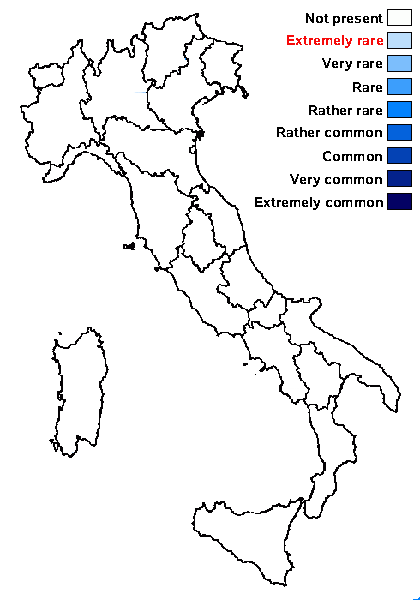Lecanora magnussoniana Hafellner & Türk
Stapfia, 76: 153, 2001
Synonyms: Squamarina magnussonii Frey & Poelt
Distribution:
Description: Thallus crustose, episubstratic, ochraceous yellow, but usually densely white-pruinose, rather thick and well-delimited, usually not forming rosettes, consisting of a few mm wide, irregular groups of areoles, the central ones small-lobulate to verrucose-subsquamulose, the peripheral ones larger (1-1.5 mm), slightly elongated but hardly radiating, easily removed from the rock, the lower part often blackened at margins. Apothecia lecanorine, scattered, 0.5-1 mm across, sessile and constricted at base, with a more or less flat, pale ochraceous to pale olive-brown, faintly pruinose disc, and a rather thick, often irregularly crenulate, strongly pruinose thalline margin. Cortex 30-40 µm thick, of anticlinally arranged, coherent hyphae, inspersed with crystals; medulla white, lax; epithecium pale brown, c. 15 µm high, with crystals; hymenium colourless, 50-70 µm high; hypothecium colourless. Asci 8-spored, cylindrical-clavate, Lecanora-type. Ascospores 1-celled, hyaline, ellipsoid, 8-9.5 x 4.5-5 µm. Photobiont chlorococcoid. Spot tests: cortex and medulla K+ bright yellow, C-, KC- or KC+ pale yellow, P-. Chemistry: cortex with usnic acid, cortex and medulla with two unknown compounds.Note: on calcareous rocks under overhangs; known from a few scattered localities in the Alps, outside Italian territory; to be looked for in the Italian Alps.
Growth form: Crustose
Substrata: rocks
Photobiont: green algae other than Trentepohlia
Reproductive strategy: mainly sexual
In underhangs rarely wetted by rain

Predictive model
Growth form: Crustose
Substrata: rocks
Photobiont: green algae other than Trentepohlia
Reproductive strategy: mainly sexual
In underhangs rarely wetted by rain

Predictive model
 Index Fungorum
Index Fungorum
 GBIF
GBIF

